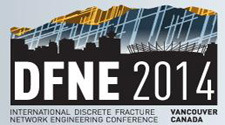
In October 2014 Alex Bond attended the DFNE-2014 conference, an international conference on Discrete Fracture Network Engineering which was held in Vancouver, Canada. This was the first dedicated DFNE conference and on the basis of the interest, another is expected in 2016 or 2017. Alex was attending as part of his DECOVALEX-2015 task leader role, presenting the work that has been done so far on Task C1 (THMC modelling of single fractures), which, judging by the questions and discussions afterwards, was well received by the audience.
Keynote speakers were Bill Derschowitz (Golder Associates), Bruce Meyer (Meyer and Associates) and Loren Lorig (Itasca International).
Bill gave an interesting talk, focussing on the hydraulic aspects of DFN modelling, emphasising the need for good and sensible conceptualisation of the system in question. In essence he warned against over-use of the stochastic approaches and that the deterministic constraints to a system at the required scale should be understood as a priority. Alternative approaches to the conventional 2D plate approximation such as hyper-convergence were also discussed and it was noted for its capacity not to over-connect the hydraulic system - a frequent drawback of the more conventional DFN approaches when applied to groundwater.
Bruce gave a fascinating talk relating to shale gas fracking with a very practical perspective that was missing from many of the presentations, where their industry use DFN in a completely different way to predict growth and propping of fracture planes. His discussion on nucleation sites for fracture initiation was especially interesting and entertaining ("it's like adding a little salt to your beer when it goes flat to get the foam back - of course a real man just pours his beer into a dirty glass...").
Loren gave an interesting talk on the use of DFNs in mining and civil applications using a range of case studies. In his presentation he described 1/3 the audience as DFN 'drug users', 1/3 as 'pushers' and the remaining third as 'waiting to pick a side', which indirectly reflected a number of the ideas that Bill Derschowitz examined. The theme of DFN as a drug was brought up later by many of the speakers - it clearly chimed with a large part of the audience!
Overall the technical content of the conference was good, with some lively discussion in the areas of geomechanics (slope and cavern stability mainly), fracking and groundwater flow and transport. The only disappointment was the organisation of the poster session. The posters and authors were only available for a short time at the end of the second day; ideally they would have been available for browsing over the whole duration of the conference. The only technical negative was that there wasn't much discussion on the suitability of DFN using representations of fractures as 2D plates for groundwater flow and thepotential utility of other representations (as raised initially in the first keynote presentation). Given the interest in future DFNE conferences, perhaps there will be scope for such slightly controversial discussions in future conferences in this series.
Update Aug 2019: Removed link to the DFNE 2014 conference website (http://www.dfne2014.ca) since it is no longer active.